Hyundai Kona 2023 Flat Tire (With Spare Tire and Tire Mobility Kit) and Towing
A strong flat tire and towing system is standard on the 2023 Hyundai Kona, giving drivers peace of mind in the event of unforeseen roadside difficulties. This system offers a complete tire mobility kit, which may contain an air compressor and sealant for short-term adjustments, in addition to a spare tire in the event of a flat tire. The Kona also has towing capacity, so in the event of more significant mechanical problems, you may securely move your car to a repair facility. Hyundai has put convenience and safety first with this integrated technology, assisting drivers in navigating around unforeseen road dangers and making sure they can swiftly and confidently resume their journey.
2023 Hyundai KONA Specs, Price, Features, Milage (Brochure)
Flat Tire (With Spare Tire and Tire Mobility Kit) and Towing
WARNING
Changing a tire can be dangerous. Follow the instructions in this section when changing a tire to reduce the risk of serious injury or death.
CAUTION
Be careful as you use the jack handle to stay clear of the flat end. The flat end has sharp edges that could cause cuts.
Jack and Tools

- Jack handle
- Jack
- Wheel lug nut wrench
The jack, jack handle, and wheel lug nut wrench are stored in the luggage compartment under the luggage box cover. The jack is provided for emergency tire changing only.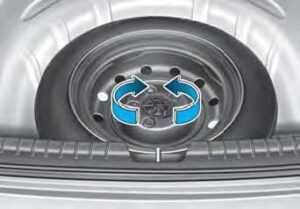 Turn the winged hold-down bolt counterclockwise to remove the spare tire. Store the spare tire in the same compartment by turning the winged hold-down bolt clockwise. To prevent the spare tire and tools from “rattling”, store them in their proper location.
Turn the winged hold-down bolt counterclockwise to remove the spare tire. Store the spare tire in the same compartment by turning the winged hold-down bolt clockwise. To prevent the spare tire and tools from “rattling”, store them in their proper location. 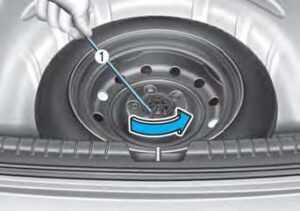 If it is hard to loosen the tire hold-down wing bolt by hand, you can loosen it easily using the jack handle.
If it is hard to loosen the tire hold-down wing bolt by hand, you can loosen it easily using the jack handle.
- Put the jack handle (1) inside of the tire hold-down wing bolt.
- Turn the tire hold-down wing bolt counterclockwise with the jack handle.
Changing Tires
WARNING
A vehicle can slip or roll off of a jack causing serious injury or death to you or those nearby.
Take the following safety precautions:
- Never place any portion of your body under a vehicle that is supported by a jack.
- NEVER attempt to change a tire in the lane of traffic. ALWAYS move the vehicle completely off the road on level, firm ground away from traffic before trying to change a tire. If you cannot find a level, firm place off the road, call a towing service for assistance.
- Be sure to use the jack provided with the vehicle.
- ALWAYS place the jack on the designated jacking positions on the vehicle and NEVER on the bumpers or any other part of the vehicle for jacking support.
- Do not start or run the engine while the vehicle is on the jack.
- Do not allow anyone to remain in the vehicle while it is on the jack.
- Keep children away from the road and the vehicle.
Follow these steps to change your vehicle’s tire:
- Park on a level, firm surface.
- Shift the shift button into P (Park).
- Press the hazard warning flasher button.
- Remove the wheel lug nut wrench, jack, jack handle, and spare tire from the vehicle.
 [A] : Block
[A] : Block - Block both the front and rear of the tire diagonally opposite of the tire you are changing.
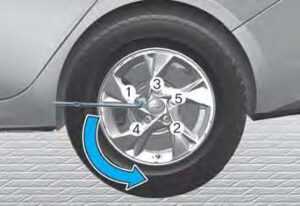
- Loosen the wheel lug nuts counterclockwise one turn each in the order shown above, but do not remove any lug nuts until the tire has been raised off of the ground.
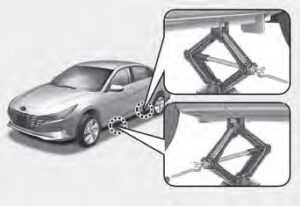
- Place the jack at the designated jacking position under the frame closest to the tire you are changing. The jacking positions are plates welded to the frame with two notches. Never jack at any other position or part of the vehicle. Doing so may damage the side sill molding or other parts of the vehicle.

- Insert the jack handle into the jack and turn it clockwise, raising the vehicle until the tire clears the ground. Make sure the vehicle is stable on the jack.
- Loosen the lug nuts with the wheel lug nut wrench and remove them with your fingers. Remove the wheel from the studs and lay it flat on the ground out of the way. Remove any dirt or debris from the studs, mounting surfaces, and wheel.
- Install the spare tire onto the studs of the hub.
- Tighten the lug nuts with your fingers onto the studs with the smaller end of the lug nuts closest to the wheel.
- Lower the vehicle to the ground by turning the jack handle counterclockwise.
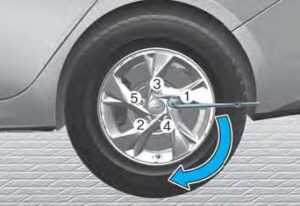
- Use the wheel lug nut wrench to tighten the lug nuts in the order shown. Double-check each lug nut until they are tight. After changing tires, have an authorized HYUNDAI dealer tighten the lug nuts to their proper torque as soon as possible. The wheel lug nut should be tightened to 79~94 lbf·ft (11~13 kgf·m). If you have a tire gauge, check the tire pressure (see “Tires and Wheels” in Chapter 2 for tire pressure instructions.). If the pressure is lower or higher than recommended, drive slowly to the nearest service station and adjust it to the recommended pressure. Always reinstall the valve cap after checking or adjusting tire pressure. If the cap is not replaced, air may leak from the tire. If you lose a valve cap, buy another and install it as soon as possible. After changing tires, secure the flat tire and return the jack and tools to their proper storage locations. If it is hard to secure the flat tire, put the flat tire in the luggage compartment.
NOTICE
Check the tire pressure as soon as possible after installing a spare tire. Adjust it to the recommended pressure. Check and tighten the wheel lug nuts after driving over 30 miles (50 km), after the spare tire is installed. Recheck the tire wheel lug nuts after driving over 620 miles (1,000 km) after the replaced tire is reinstalled.
CAUTION
Your vehicle has metric threads on the studs and lug nuts. Make certain during tire changing that the same nuts that were removed are reinstalled. If you have to replace your lug nuts make sure they have metric threads to avoid damaging the studs and ensure the wheel is properly secured to the hub. Consult an authorized HYUNDAI dealer for assistance. If any of the equipment such as the jack, lug nuts, studs, or other equipment is damaged or in poor condition, do not attempt to change the tire and call for assistance.
Use of compact spare tires (if equipped)
Compact spare tires are designed for emergency use only. Drive carefully on the compact spare tire and always follow the safety precautions.
WARNING
To prevent compact spare tire failure and loss of control possibly resulting in an accident:
- Use the compact spare tire only in an emergency.
- NEVER operate your vehicle over 50 mph (80 km/h).
- Do not exceed the vehicle’s maximum load rating or the load-carrying capacity shown on the sidewall of the compact spare tire.
- Do not use the compact spare tire continuously. Repair or replace the original tire as soon as possible to avoid the failure of the compact spare tire.
When driving with the compact spare tire mounted to your vehicle:
Check the tire pressure after installing the compact spare tire. The compact spare tire should be inflated to 60 psi (420 kPa). Do not take this vehicle through an automatic car wash while the compact spare tire is installed. Do not use the compact spare tire on any other vehicle because this tire has been designed especially for your vehicle. The compact spare tire’s tread life is shorter than a regular tire. Inspect your compact spare tire regularly and replace worn compact spare tires with the same size and design, mounted on the same wheel.
- Do not use more than one compact spare tire at a time.
NOTICE
When the original tire and wheel are repaired and reinstalled on the vehicle, the lug nut torque must be set correctly. The correct lug nut tightening torque is 79~94 lbf·ft (11~13 kgf·m).
CAUTION
To prevent damaging the compact spare tire and your vehicle:
- Drive slowly enough for the road conditions to avoid all hazards, such as potholes or debris.
- Avoid driving over obstacles. The compact spare tire diameter is smaller than the diameter of a conventional tire and reduces the ground clearance by approximately 1 inch (25 mm).
- Do not use tire chains on the compact spare tire. Because of the smaller size, a tire chain will not fit properly.
- Do not use the compact spare tire on any other wheels, nor should standard tires, snow tires, wheel covers or trim rings be used with the compact spare wheel.
- Do not suddenly accelerate or decelerate 0 25 mph (0 40 km/h) in any driving mode. It may cause leakage of transfer oil.
Jack label
The actual Jack label in the vehicle may differ from the illustration.
For more detailed specifications, refer to the label attached to the jack.
- Model Name
- Maximum allowable load
- When using the jack, set your parking brake.
- When using the jack, stop the engine.
- Do not get under a vehicle that is supported by a jack.
- The designated locations under the frame
- When supporting the vehicle, the base plate of the jack must be vertical under the lifting point.
- Shift into Reverse gear on vehicles with manual transmission or move the shift button to the P (Park) position on vehicles with automatic transmission.
- The jack should be used on the firm-level ground.
- Jack manufacture
- Production date
- Representative company and address
TOWING
Towing Service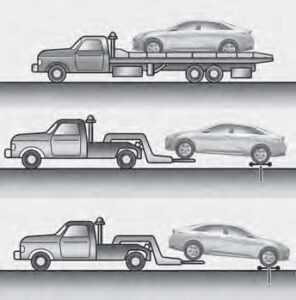 If emergency towing is necessary, have it done by an authorized HYUNDAI dealer or a commercial tow-truck service. Proper lifting and towing procedures are necessary to prevent damage to the vehicle. The use of wheel dollies or flatbeds is recommended. It is acceptable to tow the vehicle with the rear wheels on the ground (without dollies) and the front wheels off the ground. If any of the loaded wheels or suspension components are damaged or the vehicle is being towed with the front wheels on the ground, use a towing dolly under the front wheels. When being towed by a commercial tow truck and wheel dollies are not used, the front of the vehicle should always be lifted, not the rear.
If emergency towing is necessary, have it done by an authorized HYUNDAI dealer or a commercial tow-truck service. Proper lifting and towing procedures are necessary to prevent damage to the vehicle. The use of wheel dollies or flatbeds is recommended. It is acceptable to tow the vehicle with the rear wheels on the ground (without dollies) and the front wheels off the ground. If any of the loaded wheels or suspension components are damaged or the vehicle is being towed with the front wheels on the ground, use a towing dolly under the front wheels. When being towed by a commercial tow truck and wheel dollies are not used, the front of the vehicle should always be lifted, not the rear.
CAUTION
- Do not tow the vehicle with the front wheels on the ground as this may cause damage to the vehicle.
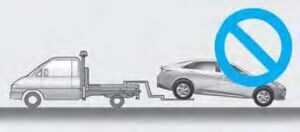
- Do not tow with sling-type equipment. Use a wheel lift or flatbed equipment.

- Do not tow the vehicle with four wheels in contact with the ground if it is the vehicle equipped with IVT. Otherwise, the transmission will be seriously damaged. Also, make sure not to tow the vehicle connecting it with other vehicles including camper vans.
WARNING
If your vehicle is equipped with a rollover sensor, place the ignition switch in the LOCK/OFF or ACC position when the vehicle is being towed. The side impact and curtain airbag may deploy if the sensor detects the situation as a rollover.
When towing your vehicle in an emergency without wheel dollies:
- Place the ignition switch in the ACC position.
- Place the shift button in N (Neutral).
- Release the parking brake.
CAUTION
Failure to place the shift button in N (Neutral) when being towed with the front wheels on the ground can cause internal damage to the transmission.
Removable Towing Hook
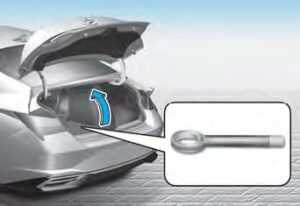
- Open the trunk, and remove the towing hook from the tool case.

- Remove the hole cover by pressing the lower part of the cover on the bumper.
- Install the towing hook by turning it clockwise into the hole until it is fully secured.
- Remove the towing hook and install the cover after use.
Emergency Towing

 If towing is necessary, have it done by an authorized HYUNDAI dealer or a commercial tow truck service. If towing service is not available in an emergency, your vehicle may be temporarily towed using a cable or chain secured to the emergency towing hook at the front (or rear) of the vehicle. Use extreme caution when towing the vehicle with a cable or chain. A driver must be in the vehicle to steer it and operate the brakes. Towing in this manner may be done only on hard-surfaced roads for a short distance and at low speeds. Also, the wheels, axles, power train, steering and brakes must all be in good condition.
If towing is necessary, have it done by an authorized HYUNDAI dealer or a commercial tow truck service. If towing service is not available in an emergency, your vehicle may be temporarily towed using a cable or chain secured to the emergency towing hook at the front (or rear) of the vehicle. Use extreme caution when towing the vehicle with a cable or chain. A driver must be in the vehicle to steer it and operate the brakes. Towing in this manner may be done only on hard-surfaced roads for a short distance and at low speeds. Also, the wheels, axles, power train, steering and brakes must all be in good condition.
CAUTION
The driver must be in the vehicle for steering and braking operations when the vehicle is being towed. Passengers other than the driver must not be in the vehicle.
Always follow these emergency towing precautions:
- Place the ignition switch in the ACC position so the steering wheel is not locked.
- Place the shift button in N (Neutral).
- Release the parking brake.
- Depress the brake pedal with more force than normal since you will have reduced braking performance.
- More steering effort will be required because the power steering system will be disabled.
- Use a vehicle heavier than your own to tow your vehicle.
- The drivers of both vehicles should communicate with each other frequently.
- Before emergency towing, check that the hook is not broken or damaged.
- Fasten the towing cable or chain securely to the hook.
- Do not jerk the hook. Apply steady and even force.

- Use a towing cable or chain less than 5 m (16 feet) long. Attach a white or red cloth (about 30 cm (12 inches) wide) in the middle of the cable or chain for easy visibility. Drive carefully so the towing cable or chain remains tight during towing. Before towing, check the Intelligent Variable Transmission (IVT) /Dual clutch transmission for fluid leaks under your vehicle. If the Intelligent Variable Transmission (IVT) /Dual clutch transmission fluid is leaking, flatbed equipment or a towing dolly must be used.
NOTICE
Accelerate or decelerate the vehicle in a slow and gradual manner while maintaining tension on the tow rope or chain to start or drive the vehicle, otherwise, tow hooks and the vehicle may be damaged.
NOTICE
To avoid damage to your vehicle and vehicle components when towing:
- Always pull straight ahead when using the towing hooks. Do not pull from the side or at a vertical angle.
- Do not use the towing hooks to pull a vehicle out of mud, sand or other conditions from which the vehicle cannot be driven out under its own power.
- Limit the vehicle speed to 10mph (15km/h) and drive less than 1 mile (1.5 km) when towing to avoid serious damage to Intelligent variable transmission.
- The Intelligent variable transmission vehicle can be towed to a normal vehicle only without oil leakage.
Check for oil leaks. Towing the vehicle with oil leakage may damage the transmission.
FAQ
Does the Hyundai Kona 2023 come with a spare tire?
Yes, the Hyundai Kona 2023 is typically equipped with a spare tire as part of its standard equipment.
What type of spare tire does the Kona 2023 come with?
The Kona 2023 usually comes with a compact temporary spare tire, also known as a “donut” spare tire.
How long can I drive on the temporary spare tire?
Temporary spare tires are designed for short-term use and limited distances. It is recommended to drive on the temporary spare tire only until you can reach a repair shop or replace the damaged tire.
Does the Kona 2023 come with a tire mobility kit?
Yes, in addition to the spare tire, the Kona 2023 may also come with a tire mobility kit. The kit typically includes sealant and an air compressor to temporarily repair minor tire punctures.
How does the tire mobility kit work?
The tire mobility kit allows you to seal small punctures and inflate the tire temporarily. It is intended as a temporary solution to get you to a repair shop where the tire can be properly repaired or replaced.
Can the tire mobility kit be used for all types of tire damage?
The tire mobility kit is suitable for repairing minor punctures caused by nails, screws, or similar objects. It may not be effective for larger or more severe tire damage.
How far can I drive with the tire repaired using the mobility kit?
The tire mobility kit is meant as a temporary fix. It is recommended to drive to a repair shop as soon as possible after using the kit, rather than relying on the repaired tire for an extended period.
Can I use the tire mobility kit on the sidewall of the tire?
No, the tire mobility kit is not designed to repair sidewall damage. If the sidewall of the tire is damaged, it is best to replace the tire.
What should I do if the tire damage cannot be repaired with the mobility kit?
If the tire damage is beyond the capabilities of the tire mobility kit, it is recommended to contact a roadside assistance service or arrange for towing to a repair shop.
Is towing covered under the Kona 2023’s warranty?
Warranty coverage for towing may vary depending on the specific terms and conditions of your Hyundai Kona 2023 warranty. It is advisable to refer to your warranty documentation or contact Hyundai customer service for accurate information.
How can I arrange for towing if needed?
In case of a flat tire or another breakdown that requires towing, you can contact a roadside assistance service, such as Hyundai’s roadside assistance program or a third-party service, to arrange for towing.
Does the Kona 2023 have towing hooks or attachment points?
The Kona 2023 typically comes equipped with towing hooks or attachment points, located at the front and rear of the vehicle, to facilitate safe towing when necessary.
Can the Kona 2023 be towed with all wheels on the ground?
The specific towing instructions for the Kona 2023 can be found in the owner’s manual. It is essential to follow the manufacturer’s guidelines to ensure safe and proper towing.
Can towing damage the Kona 2023?
Towing, when done correctly and within the recommended guidelines, should not cause damage to the Kona 2023. It is important to use proper towing equipment and techniques to minimize any potential risks.
What should I do if I encounter a flat tire while driving the Hyundai Kona 2023?
If you experience a flat tire while driving the Hyundai Kona 2023, follow these steps:
-
- Safely pull over to the side of the road, away from traffic.
- Activate your hazard lights to alert other drivers.
- Assess the damage to the tire. If it can be repaired using the tire mobility kit, follow the instructions provided with the kit.
- If the tire damage cannot be repaired with the mobility kit, use the spare tire instead.
- Locate the spare tire, which is typically stored in the trunk or under the vehicle.
- Use a jack to lift the vehicle and remove the flat tire.
- Install the spare tire and tighten the lug nuts securely.
- Lower the vehicle with the jack and ensure the spare tire is properly inflated.
- Drive to a repair shop or tire professional to either repair or replace the damaged tire as soon as possible.
- Remember that the spare tire is intended for temporary use only and should be replaced with a full-sized tire at the earliest opportunity.
Useful Link
View Full User Guide: Hyundai Kona 2023 User Guide
Download Manuals: https://owners.hyundaiusa.com/us/en/resources/manuals-warranties.html
2023 Hyundai KONA Specs, Price, Features, Milage (Brochure)


